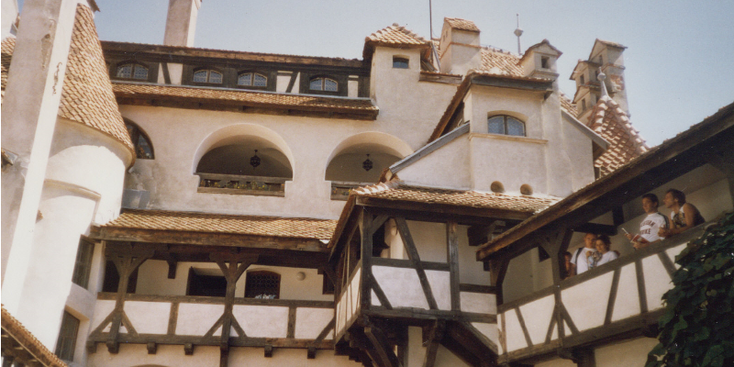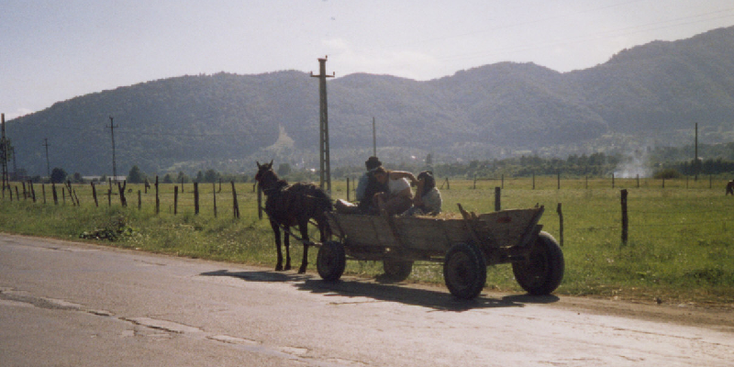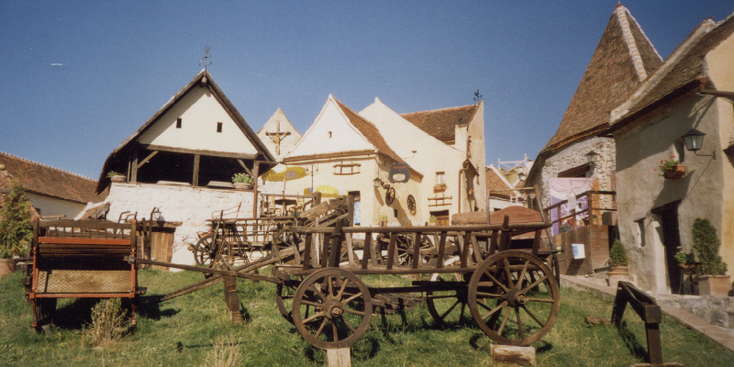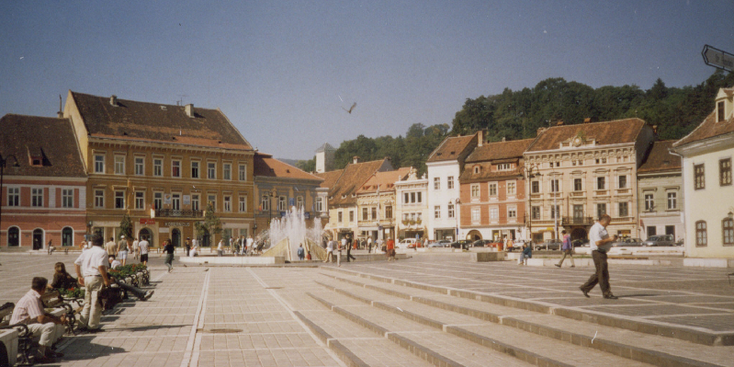Brasov
Places of Interest - Romania


introduction
Brasov is an old medieval town in the heart of Romania on the southeast side of the province Transylvania. With its originally very mixed group of inhabitants it is a very popular tourist attraction of the country. The old town, known in German as Kronstadt is best known for its Gothic black church - but it also has a beautiful market square with many nice terraces and shops.
Brasov is surrounded by mountains where Mt. Tampa is the most famous one (you can hike it up in summer and in winter you can ski here but also enjoy the view). These mountains are also the habitat of the wild bear, who often come down in town in the evening and have “diner” from the trash-cans in the city. The city also offers an excellent base for attractions located outside the city; the famous Dracula castle Bran and the beautiful Rasnov castle.
highlights

The historic city center:
The heart of the medieval city Brasov is formed by the Piata Sfatului with the 15th century town hall which is built in the middle of the square. One of the towers of the building would be "bewitched" - it seems that countless examples of torture have taken place in the tower. The last witch-burning of Europe would have been carried out on the square.
One of the urban characteristics of Brasov is the black church; the largest Gothic church in town that is located between Vienna and Istanbul was built in the 15th century and owes its name to a great fire in 1689. Pay particular attention to the beautiful tapestries hanging from the balconies - taken and donated by traders from the East.
In the east of the city center you can visit one of the narrowest streets in Europe - it is Str. Storii and is only 132 cm wide. The old center of Kronstadt with its cobbled stone streets is filled with cozy terraces, (souvenir) shops and there are plenty of museums where you can have fun on a rainy day. A long city wall (3 km) was built around the historic center to defend the city against Turkish attacks. The walls are 12 meters high.

Watching bears:
The city Brasov is also (in)famous for its wild bears who can search their food on some winter evenings (also in the summer) in trash cans in the outskirts of the city.
There would still be about 6,000 brown bears living in Romania and many of that number lives in the mountains around Brasov. In the city there are a number of organizations that provide bear-tours to admire the animals in this unnatural way of keeping themselves alive.
It turns out that through this "acquaintance" with people, the bears are increasingly approaching our habitat and attacking humans. Kitchens in Brasov have not been safe in recent years and there is even someone who was sleeping on a couch at night near the center torn into pieces.
-
Rasnov and Bran castle (Rasnov): see museum.
Other attractions:
- Mt. Tampa (where you can hike, ski or just enjoy the view over the city of Brasov).

history
In the 13th century the city Brasov was founded on an old Dacian place by the Teutonic Knights who called it Kronstadt. Thus it became a German colony city where the Saxon population built churches and houses that were protected by a gigantic city wall. The Romanians lived a bit further in a village known as Schei.
In the year 1458, Prince Vlad Tepes for the first time attacked the defensive positions of the city that were built on top of Mt Tampa. Two years later he would occupy the city and customarily sell 40 sellers to impale. Over the years, Brasov became more and more home to other population groups; first by many Hungarians (at the beginning of the 20th century they were a majority), but nowadays the city is largely Romanian.
Between 1950 and 1960 when Romania was still under the communist yoke of the Soviet Union, the name of Kamerad Stalin was artificially cut from a piece of green on the mountain Tampa. At that time the city called itself Orasul Stalin" after the name of the Russian dictator. One of the first public opposition to the dictator Ceasusescu was in Brasov; it was 1987 when thousands of aggrieved workers took to the streets to demand "food". The army was invoked and three people died in chaos.

tips & advice (2004)

Brasov - Bucharest: you can best take the train of which there are about 15 per day. The journey takes about 2.5 hours. The price (2010) was 37 Lei.
From Brasov to Sighisoara: This train ride also takes about 2.5 hours - costs 32 Lei (2010) - there are about 18 (fast) trains a day.

-
Name: Rasnov castle (Cetatea)
Price: 10 Lei (2010)
Time: 09:00 - 17: 00/18: 00
Phone nr. : 0730-933 006
Content:
Located in the small town Rasnov, about 18 km from Brasov, lies the beautiful citadel with the same name. Built in the year 1215 by the Teutonic Order of Knights to protect the fertile Farmland surrounding the castle against the Turks (later against the Tartars). This "open" plain was also used to “see” the enemy approaching. You can after a 15 minute walk from the parking lot visit the castle; there is a church, a prison and beautiful views over the Transylvanian landscape.
It appears that when the castle was besieged, two Turkish prisoners were asked to dig a well. If they would hit a (water)source they would get their freedom back. It would take the gentlemen some 17 years before this was achieved - the well is still usable - it is 143 meters deep. The castle and its grounds are a lot quieter (read: more pleasant) than the nearby "madhouse" of the castle of Bran (see below) and makes for a good change (and picnic lunch).
-
Name: Bran castle
Price: 12 Lei (2010) and 10 Lei for photos / 18 for films (is ignored by almost everyone)
Time: 09:00 - 16: 00/18: 00
Phone nr. : 02680238332
Website: www.brancastlemuseum.ro
Content:
It is perhaps a disappointment of many who have heard about the Dracula castle, but Prince Vlad Tepes may have
stayed here for a night when he fled from the Turks. Despite all the fuss, souvenirs and stories you will hear, this castle has nothing to do with the bloodthirsty count. Nevertheless, it must be said that the pointed towers of the castle, the narrow passageways, the view over the dark landscape of Transsyylvanie, the hidden stairs and the small courtyard would have been a beautiful scene.
Like Rasnov castle, this castle was built by the Teutonic Order of Knights in the 14th century to protect the region against Turkish attacks. First a wooden one, from 1377 the Hungarians (under King Sigmund of Hungary) worked on a stone example. From 1920 onwards, Queen Marie lived here, who is primarily responsible for the vast majority of the furniture you see in the castle today. It was used as a summer residence for all Romanian kings until the deposition of King Michael in 1947. Ten years later it became a museum.
From the "soldiers" watchtower in the castle you can still see the remains of the defensive walls that separated the province Transylvania from Wallachia. A memorial in the form of a tomb (where the heart of Queen Marie would lie) can be seen at the end of the wall. In 2006 - after 60 years in the hands of the Communists - the key of the famous castle was returned to the rightful owner (read: the grandson of Queen Marie) who was not at all happy with the Dracula circus.
He put it on sale a year later for 100 million euros - after two years of being sold the family decided to withdraw the purchase. The castle is located thirty kilometers from Brasov.

see also:
LANDEN:
EUROPA:
Albanië * België * Bosnië-Herzegovina * Bulgarije * Denemarken * Duitsland * Engeland * Estland * Finland * Frankrijk * Griekenland * Hongarije * (Noord) Ierland * Italië * Kosovo * Kroatië * Letland * Litouwen * Luxemburg * Macedonië * Malta * Montenegro * NEDERLAND * Oekraïne * Oostenrijk * Polen * Portugal * Roemenië * Rusland * Schotland * Servië * Slovenië * Slowakije * Spanje * Tsjechië * Turkije * Zweden
NOORD EN CENTRAAL-AMERIKA:
Chili * Costa Rica * Cuba * Guatemala * Mexico * Nicaragua * Panama * Verenigde Staten
ZUID-AMERIKA:
Argentinië * Bolivia * Brazilië * Colombia * Ecuador * Peru
AFRIKA:
Botswana * Burkina Faso * Egypte * Ethiopië * Ghana * Kenia * Mali * Marokko * Namibië * Oeganda * Senegal * Tanzania * Tunesië * Zuid-Afrika
MIDDEN-OOSTEN:
Iran * Israël * Jordanië * V.A.E.
AZIE:
Armenië * Cambodja * China * Filipijnen * Georgië * India * Indonesië * Japan * Kirgizië * Laos * Maleisië * Mongolië * Myanmar * Nepal * Oezbekistan * Singapore * Sri Lanka * Thailand * Vietnam
OCEANIE:
Voor meer reisfoto's kijk op www.instagram.com/cheapskatetravel.nl:
© Cheapskatetravel.nl; 2018 (all rights reserved)


